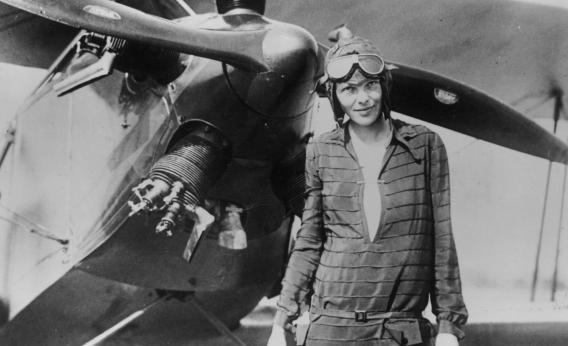The publisher George Palmer Putnam proposed to Amelia Earhart six times before she agreed to marry him. First, she served him a letter detailing “some things which should be writ before we are married.” She would not be faithful: “I want you to understand I shall not hold you to any midaevil code of faithfulness to me nor shall I consider myself bound to you similarly,” Earhart wrote. She would not quit flying: “Please let us not interfere with the others’ work or play.” And she would not commit to forever: “I must exact a cruel promise and that is you will let me go in a year if we find no happiness together.” They married on Feb. 7, 1931.
I stumbled upon Earhart’s prenup last week, nestled in Purdue’s online library of her letters. I posted it to my Tumblr. Hundreds of women approved. Earhart’s prenup has been quoted before, but it seems to have struck a chord at this particular point in relationship history. Lori Adelman of Feministing called it “a pretty darn modern vision of marriage.” At the Frisky, Amelia McDonell-Parry also praised Earhart’s “incredibly modern view,” including “expressing her weariness of the institution itself, and then laying out her expectations for such a union, which include a willingness to be monogam-ish … and a need for privacy and respect for her career aspirations.”
Earhart wrote her views on marriage over 80 years ago, but it speaks to our contemporary ambivalence about the institution. The marriage rate among adults in the U.S. has dropped steadily over the past 50 years, from 72 percent in 1960 to 51 percent in 2010. The average American now marries at the tail end of his or her 20s, not the beginning. (Earhart married at 33, when the average age for a woman’s first marriage was 21.) But though 39 percent of Americans feel “marriage is becoming obsolete,” most of us still say we would “like to marry someday.” There are those of us who yearn for our casual relationships to turn into marital commitments, and others who break after years of sworn spinster or bachelorhood. And yet we remain wary of the legal hassles, entrenched gender inequalities, and lingering social expectations that accompany the marriage contract.
So like Earhart, we attempt to assert our individuality even as we agree to tether ourselves to a pair. We all sign the same papers, then proclaim our marriages will be different. Like Liz Lemon, we protest about the absurdity of the thing that we are doing (or as one woman wrote in response to Earhart’s letter, “My prenup with Seth just says ‘hot dogs,’ written on a napkin”). And we stage indie ceremonies to avoid the conservative trappings of the traditional package.
Dana LaRue, the editor-in-chief of alternative wedding site The Broke-Ass Bride, told me that she’d like to see marriage evolve “as a social construct away from a ‘lifetime commitment under God’ and more toward a ‘civil union in whatever form speaks most to those involved.’” And yet what ends up “speaking to us” today isn’t necessarily so different from what used to. “I think the ambivalence is more toward the governmental ‘sanctity’ of marriage as an institution than to committed domestic partnership as a concept,” LaRue says. “This ambivalence doesn’t detract from our desires to celebrate our love and union with our families, friends and communities. Weddings are still attractive.”
Maybe part of our confusion stems from the fact that our “modern” view of marriage is actually quite retro. As sociologist Claude Fisher explains, “Marrying rates and ages around the turn of the 21st century are more like those a century ago.” The United States reached peak spinster in 1920, and there was a higher percentage of never-married women in 1930 than in 1998. And though Americans are marrying older today than we used to, we’re making up most of the difference by cohabiting first, not by flying around the world.
Also confusing: When we quote figures marking the decline of marriage since 1960, we’re not looking back far enough. According to Fisher, “it was the 1950s-60s that were most unusual—not our era.” As Putnam wrote in a magazine article detailing his own perceived “alternative” marriage in the 1930s, “Thousands of wives and husbands are operating on exactly the same basis, successfully and happily. It’s not even ‘modern’ anymore.”
Of course, marriages are different now, thanks to legal, medical, and social advances in contraception, domestic violence legislation, divorce, women’s representation in the workforce, and the rise of gay marriage. Unmarried women today are not socially marginalized and tucked into the attic like the spinsters of yore. And yet, given the seemingly endless relationship models we can choose from today, it seems odd that we “modern” woman would find comfort—and even vow inspiration—in the views of a woman who seems not to have wanted to marry at all. “You must know again my reluctance to marry, my feeling that I shatter thereby chances in work which means most to me,” she told Putnam. “I feel the move just now as foolish as anything I could do. I know there may be compensations but have no heart to look ahead.”
